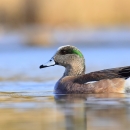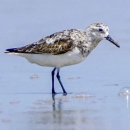Seasons of Wildlife
Located in the northwest corner of Washington State on the Salish Sea, approximately 60 miles northwest of Seattle, Dungeness National Wildlife Refuge offers a diversified habitat of sand beaches, protected bay waters, seagrass beds, mudflats, and forested and grass uplands. Good wildlife viewing opportunities occur throughout the year.
Winter
In winter, the area is important to sea ducks and other waterfowl who feed and find storm shelter in the protected waters of Dungeness Bay. The Bay remains an important migration stop and wintering ground for brant. Many shorebird species also feed on the shorelines and mudflats during the spring and fall migrations with a few species overwintering on the Refuge. Bald eagles and other raptors are commonly seen year round on the Refuge.
Summer
Summer brings nesting songbirds to the forested and grass uplands and on to the spits. Often visitors see harbor seals swimming in the marine waters and hauling out on shore to rest and nurse their pups within the protection of the Refuge boundaries. Visitors have also spotted other marine mammals, such as orca and minke whales, in Refuge waters.
Featured Species
With its rich and diverse habitats, Dungeness supports more than 240 species of birds, 29 species of mammals, 8 species of reptiles and amphibians, and 26 species of fish. Here just are a few.
Birds
Dungeness is best known for its population of brant, but it also supports a wide range of other ducks and geese.
Mammals
From the Douglas' squirrels chattering in the tree branches to harbor seals resting on shore, mammals abound throughout Refuge habitats.
Habitat
From the silty depths of the mudflats to dizzying heights of a Douglas fir, the habitats of Dungeness are a fertile mosaic for wildlife.












